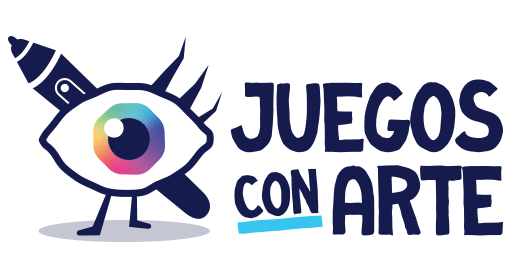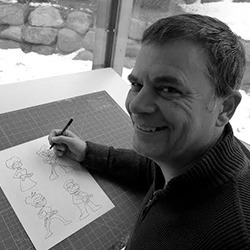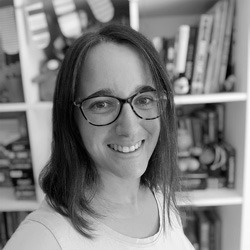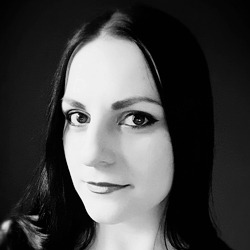
Hemos tenido el enorme honor de entrevistar a la ilustradora de juegos de mesa Agnieszka Dabrowiecka, responsable del arte de grandes juegos como Castles of Mad King Ludwig, Frostpunk, La Granja Edición Deluxe y actualmente está trabajando en la tercera temporada de Final Girl «The Tormentor«
Te dejamos con la entrevista, no olvides compartir la entrevista si te ha gustado 😉.
ENG | Welcome Anez, thank you for collaborating with us! For our readers who don’t know your work yet, could you tell us a little about yourself and your professional career?
Hi there! Thanks for having me here!
My name is Agnieszka «Anez» Dąbrowiecka. I’m a freelance artist and board game illustrator based in Poland. I’ve worked professionally on board game illustrations for almost a decade, and I’ve cooperated with many board game publishers like Bezier Games, Stonemaier Games, Van Ryder Games, Glass Cannon Unplugged. I like to laugh that in the game industry I am most likely known as «the Castles girl”, as more than half of my professional projects were somehow connected to Castles of the Mad King Ludwig in one version or another. I’m specializing in fantasy and historical themed illustrations, and these are my personal favourite genres of films, books, games and animations.
ESP | Bienvenida Anez, ¡gracias por colaborar con nosotros! Para nuestros lectores que aún no conocen tu trabajo, ¿podrías hablarnos un poco de ti y de tu trayectoria profesional?
¡Hola! ¡Gracias por invitarme!
Me llamo Agnieszka «Anez» Dąbrowiecka. Soy una artista independiente e ilustradora de juegos de mesa afincada en Polonia. He trabajado profesionalmente en ilustraciones de juegos de mesa durante casi una década, y he cooperado con muchos editores de juegos de mesa como Bezier Games, Stonemaier Games, Van Ryder Games, Glass Cannon Unplugged. Me gusta reírme de que en el sector de los juegos se me conozca como «la chica de los castillos», ya que más de la mitad de mis proyectos profesionales estaban relacionados de algún modo con Castillos del Rey Loco Ludwig en una u otra versión. Estoy especializada en ilustraciones de temática fantástica e histórica, y estos son mis géneros favoritos personales de películas, libros, juegos y animaciones.

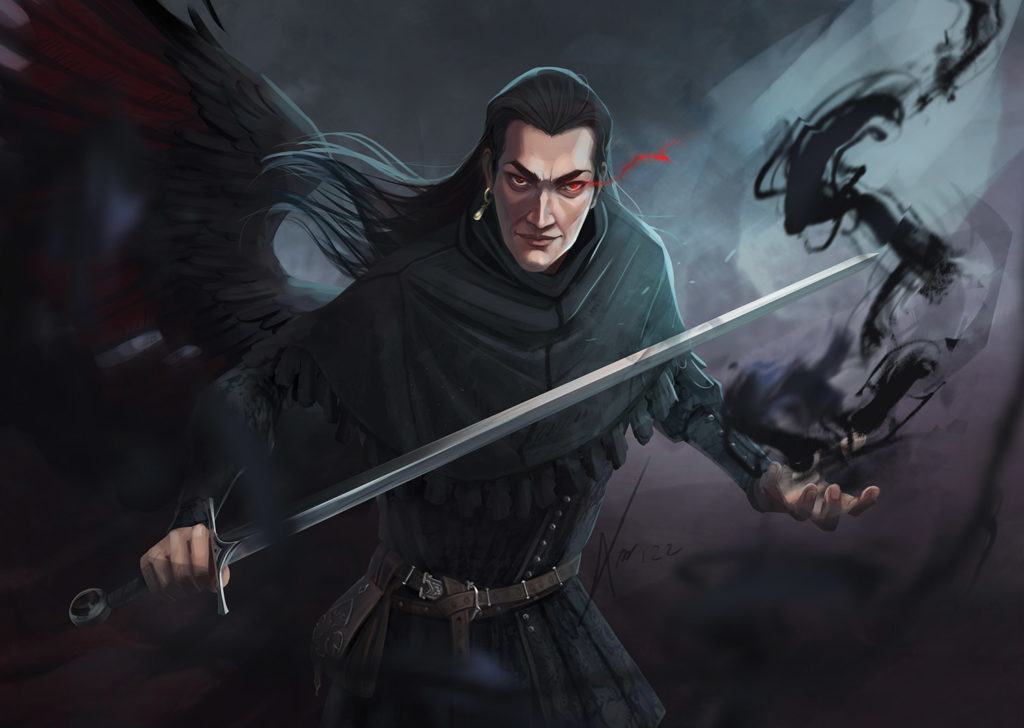

ENG | What are your references, what inspires or influences you to work?
In my personal artworks you can find mostly portraits of pointy-eared characters in oriental inspired clothes. This came from my fascination with traditional costumes of India and the Middle East, mixed with love for the Lord of the Rings and Forgotten Realms world, as well as some slavic mythology inspired elements. This could sound like a quite crazy mix, but somehow it works 🙂
For my professional work I search for references suited for the game topic. Often – since they are mostly historical themed – I look for historical sources like paintings, photos, museum objects of preserved clothes and everyday items. A need for good research before work came from my private life hobby. With my family and friends we are involved in 14th and 17th century reenactment. For the last 19 years I learned a lot about European historical fashion and culture and I put great value to the good references.
The other kind of references are pictures helping to achieve a specific «look» for a board game. My latest two projects for Glass Cannon Unplugged were video game adaptations. And we needed to have the exact same look and feeling to the buildings you know from those games.
For the Frostpunk I did over a 180 printscreens from the videogame, which also required playing the actual game (huge thanks to my beloved husband, who did the whole work). I also had countless amount of references for snow, and concrete for the second game adaptation – Apex Legends.
ESP | ¿Cuáles son sus referencias, qué le inspira o influye a la hora de trabajar?
En mis obras personales se pueden encontrar sobre todo retratos de personajes de orejas puntiagudas con ropas de inspiración oriental. Esto procede de mi fascinación por los trajes tradicionales de la India y Oriente Próximo, mezclada con mi amor por el mundo de El Señor de los Anillos y Reinos Olvidados, así como algunos elementos inspirados en la mitología eslava. Podría parecer una mezcla bastante loca, pero de algún modo funciona 🙂
Para mi trabajo profesional busco referencias adecuadas para el tema del juego. A menudo -ya que la mayoría son de temática histórica- busco fuentes históricas como cuadros, fotos, objetos de museo de ropa conservada y objetos cotidianos. La necesidad de investigar bien antes de trabajar surgió de mi afición en la vida privada. Con mi familia y amigos participamos en recreaciones de los siglos XIV y XVII. Durante los últimos 19 años he aprendido mucho sobre la moda y la cultura históricas europeas y valoro mucho las buenas referencias.
El otro tipo de referencias son las imágenes que ayudan a conseguir un «look» específico para un juego de mesa. Mis dos últimos proyectos para Glass Cannon Unplugged eran adaptaciones de videojuegos. Y necesitábamos que los edificios que conocemos de esos juegos tuvieran exactamente el mismo aspecto y la misma sensación.
Para el Frostpunk hice más de 180 capturas de pantallas del videojuego, lo que también requirió jugar al juego real (muchas gracias a mi querido marido, que hizo todo el trabajo). También tenía innumerables referencias de nieve y hormigón para la adaptación del segundo juego, Apex Legends.


ENG | How did you first get involved in the illustration of a board game and what did you learn from that project?
My first game board illustration project was for the Polish edition of Castles of Mad King Ludwig by Ted Alspach. I got this project totally by an accident. I did a few test drawings and the author liked them so much that the Polish publisher got the green light for the project with my art.
Back then we did over 85 different castle rooms, as well as other elements and a box cover for the game. I did a great research for them, looking for interiors of the original Ludwig’s castles. As long as the game mechanics allowed I tried to capture the most «iconic» elements in these tiny tiles. Like elements from the original kitchen, beautiful floor from the Tasso Room, or a stage and a swan boat in the Venus Grotto. If you are interested in this topic there is a great documentary «Neuschwanstein: King Ludwig‘s dream castle and its secret» you can watch it on Youtube. It turned out to be very helpful with the project as well.
ESP | ¿Cómo se involucró por primera vez en la ilustración de un juego de mesa y qué aprendió de aquel proyecto?
Mi primer proyecto de ilustración de un juego de mesa fue para la edición polaca de Castles of Mad King Ludwig, de Ted Alspach. Conseguí este proyecto totalmente por accidente. Hice unos dibujos de prueba y al autor le gustaron tanto que el editor polaco dio luz verde al proyecto con mi arte.
Por aquel entonces hicimos más de 85 habitaciones de castillo diferentes, así como otros elementos y una portada para la caja del juego. Hice una gran investigación para ellos, buscando interiores de los castillos originales de Ludwig. En la medida en que la mecánica del juego lo permitía, intenté plasmar los elementos más «icónicos» en estas pequeñas losetas. Como elementos de la cocina original, el hermoso suelo de la Sala Tasso, o un escenario y un barco cisne en la Gruta de Venus. Si le interesa este tema, hay un gran documental «Neuschwanstein: El castillo soñado del rey Luis y su secreto» que puedes ver en Youtube. También resultó muy útil para el proyecto.
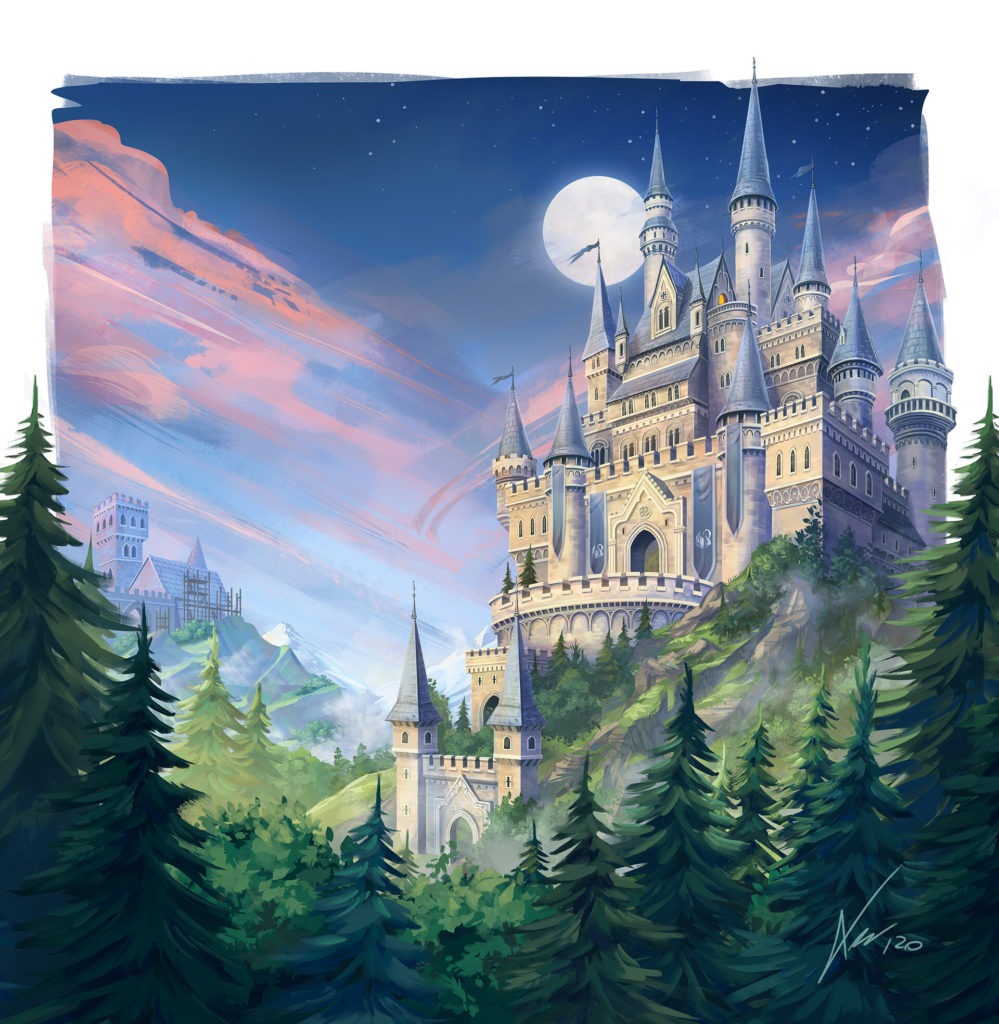
ENG | We would like to highlight your work for Castles of Mad King Ludwig Collector’s Edition. How has it been to illustrate the same game again after so long?
Ha ha, it was… challenging and hard at the same time. It takes a few years from the first game to the last expansion, and my style has developed a lot from that time. I needed to make it, though in the exact same style for the game compatibility.
ESP | Nos gustaría destacar tu trabajo para Castles of Mad King Ludwig Collector’s Edition. ¿Cómo ha sido volver a ilustrar el mismo juego después de tanto tiempo?
Ha ha, ha sido… desafiante y difícil al mismo tiempo. Pasan unos cuantos años desde el primer juego hasta la última expansión, y mi estilo ha evolucionado mucho desde entonces. Necesitaba hacerlo, aunque exactamente con el mismo estilo para que el juego fuera compatible.

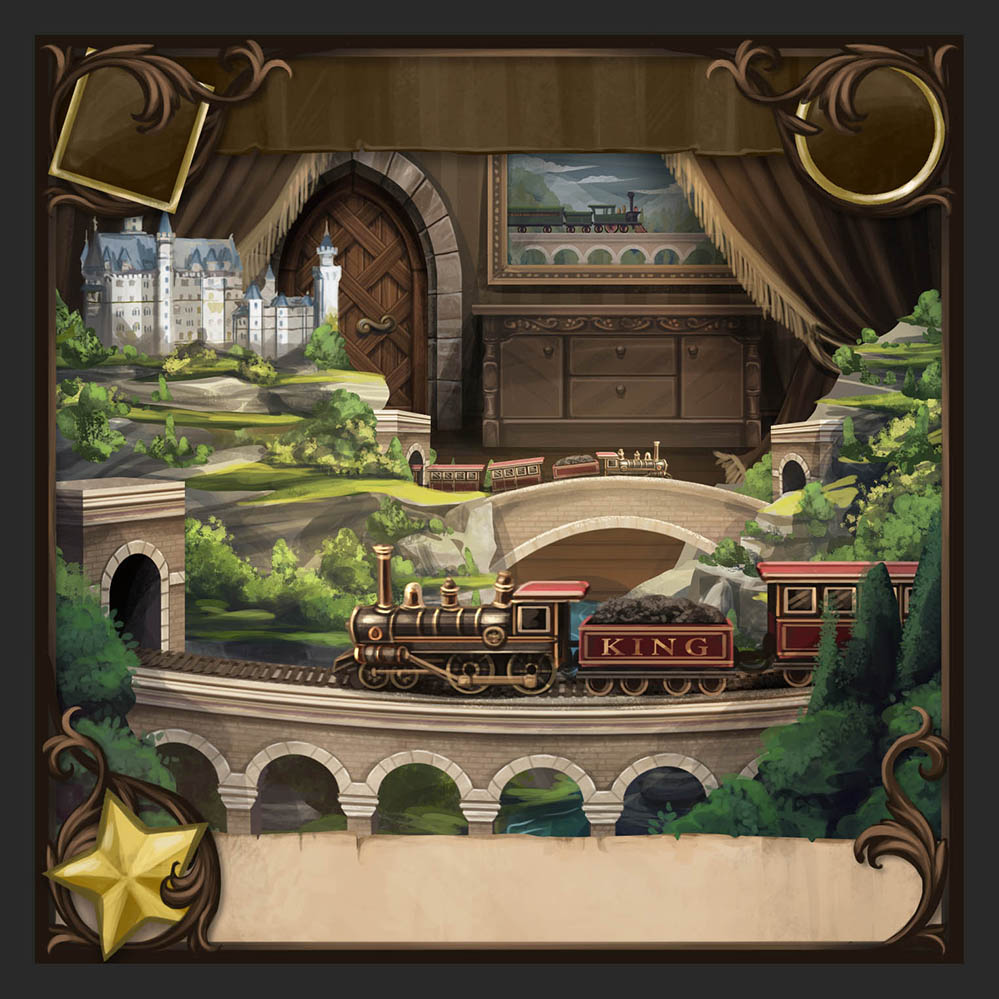
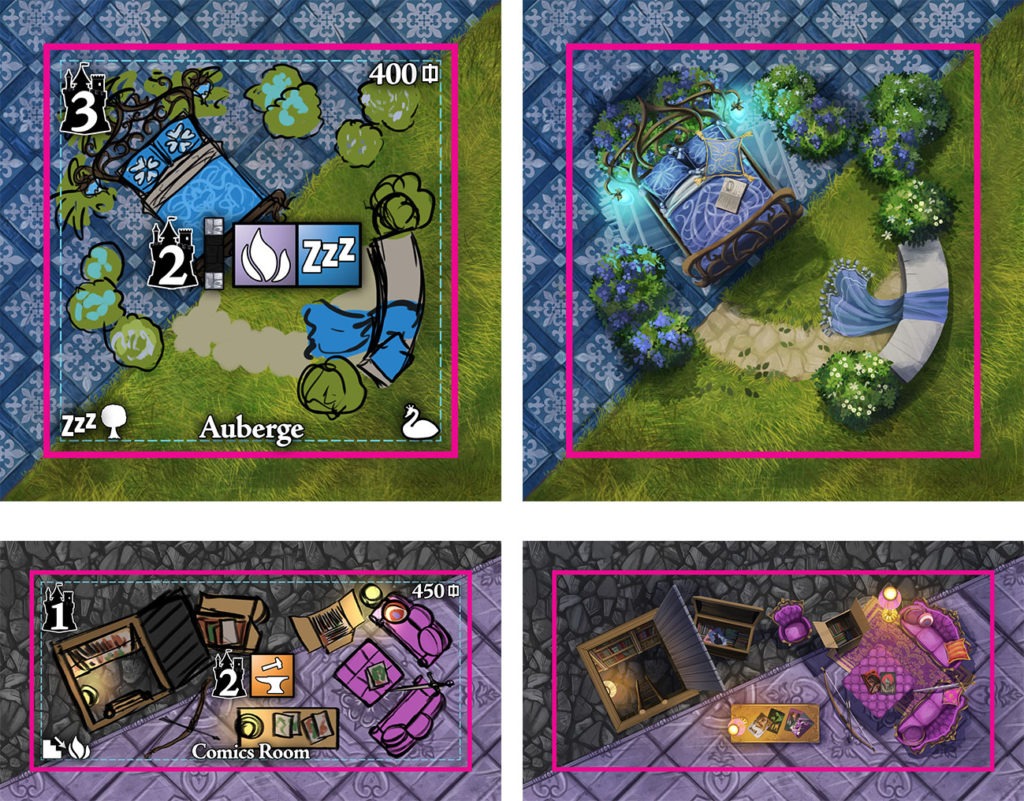
ENG | You have illustrated more than 100 tiles in great detail in the game, we can even find some easter eggs… Could you tell us what we can find so that our readers can have fun looking for them?
You probably noticed some board game boxes here and there. As well as some cute animals traveling through the castle’s chambers. There is also a LOTR inspired bedroom, with a book describing the One Ring on the bed. In one of the purple rooms you can find a map with military plans of the Grunwald battle (the biggest medieval battle in Poland). If you’ll check the expansion’s tiles you could also find Alice’s Rabbit hole, Indiana Jones hat, and a Frodo’s Sting. There is one easter egg that is so «niche» that I bet that no one could ever recognize it. In one room there are some graphic novel covers. You can find there: Thorgal, Witcher, Hulk and… a portrait of my original DnD character – that my fans from my Instagram could probably recognize – a purple Tiefling I named Rajiah.
ESP | Has ilustrado más de 100 losetas con todo lujo de detalles, incluso podemos encontrar algunos easter eggs… ¿Podrías decirnos qué podemos encontrar para que nuestros lectores se diviertan buscándolos?
Seguramente habrás visto algunas cajas del juego de mesa aquí y allá. Así como algunos simpáticos animales que viajan por las cámaras del castillo. También hay un dormitorio inspirado en LOTR, con un libro que describe el Anillo Único sobre la cama. En una de las habitaciones de color púrpura encontrarás un mapa con planos militares de la batalla de Grunwald (la mayor batalla medieval de Polonia). Si echas un vistazo a las fichas de la expansión, también podrás encontrar la madriguera del Conejo de Alicia, el sombrero de Indiana Jones y un Aguijón de Frodo. Hay un easter egg que es tan «nicho» que apuesto a que nadie podría reconocerlo. En una habitación hay algunas portadas de novelas gráficas. Puedes encontrar allí: Thorgal, Witcher, Hulk y… un retrato de mi personaje original de DnD – que mis fans de mi Instagram probablemente podrían reconocer – un Tiefling púrpura al que llamé Rajiah.

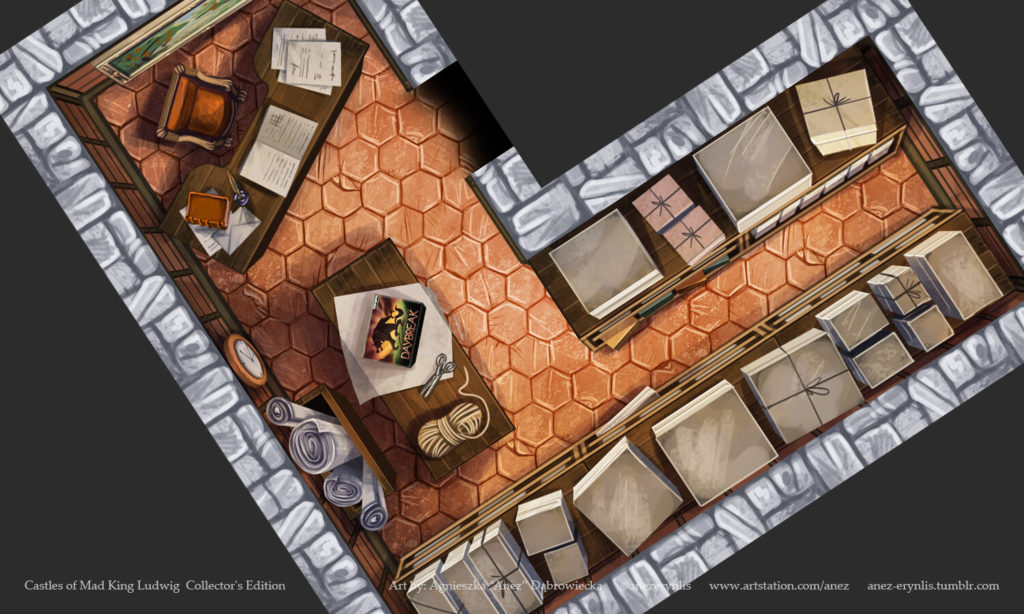

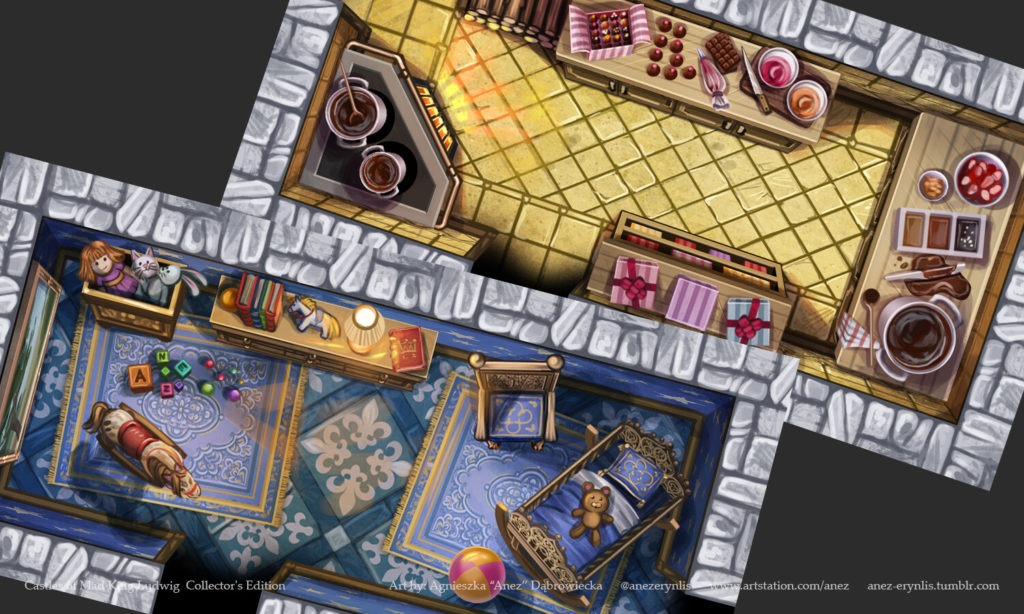
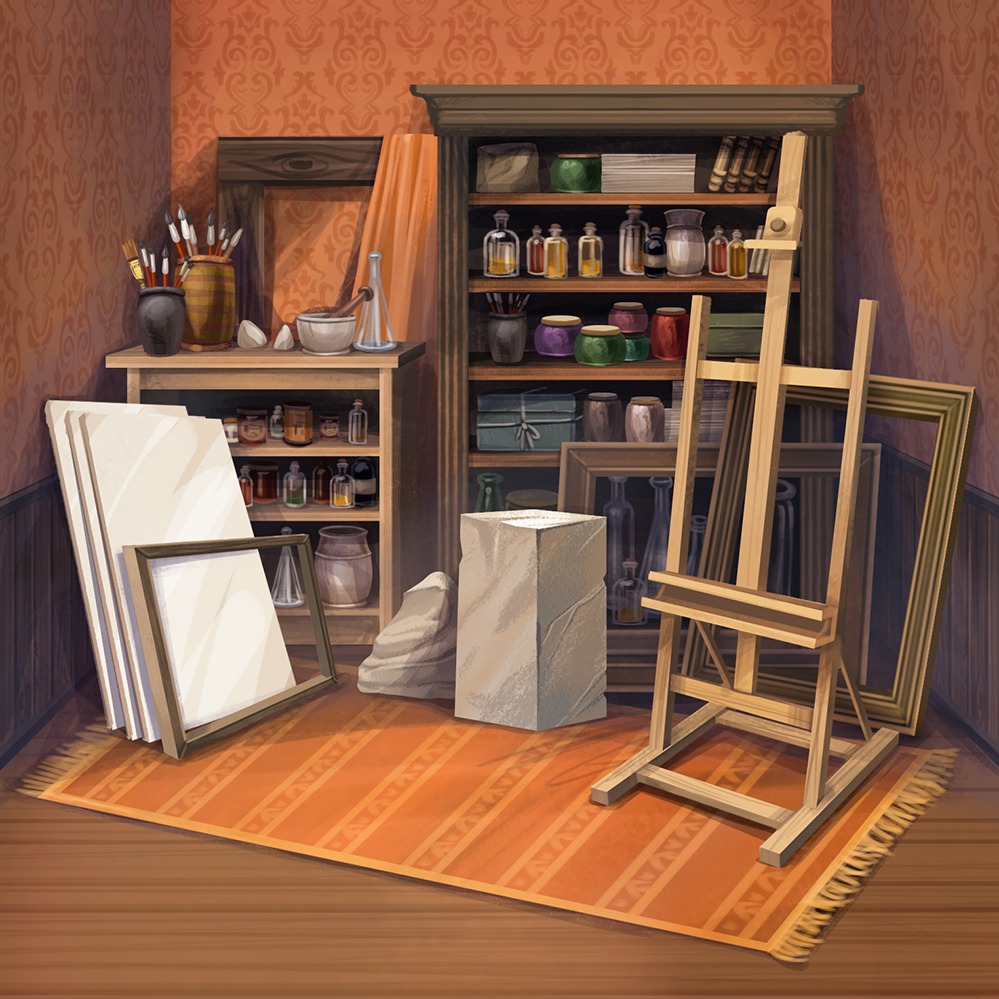
ENG | Among all your works we want to focus on the development of the Deluxe edition of La Granja, created by Michael Keller and Andreas Odendahl and published by Maldito Games in Spain. How did you join the project and what was the first thing you thought when you learned about its theme?
I was asked directly by the Polish publisher Board & Dice if I want to make illustrations for their new project.
I was just after finishing The Frostpunk, drawing tons of snowy, freezing cold environments, also in the very middle of the grim and overwhelming pandemic going around, so the idea of a sunny 19th century inspired Mallorca was a fabulously refreshing project .
ESP | Entre todos tus trabajos queremos centrarnos en el desarrollo de la edición Deluxe de La Granja, creada por Michael Keller y Andreas Odendahl y publicada por Maldito Games en España. ¿Cómo te uniste al proyecto y qué fue lo primero que pensaste al conocer su temática?
La editorial polaca Board & Dice me preguntó directamente si quería hacer ilustraciones para su nuevo proyecto.
Acababa de terminar The Frostpunk, dibujando montones de entornos nevados y helados, también en medio de la sombría y abrumadora pandemia que se está produciendo, así que la idea de una soleada Mallorca inspirada en el siglo XIX fue un proyecto fabulosamente refrescante…
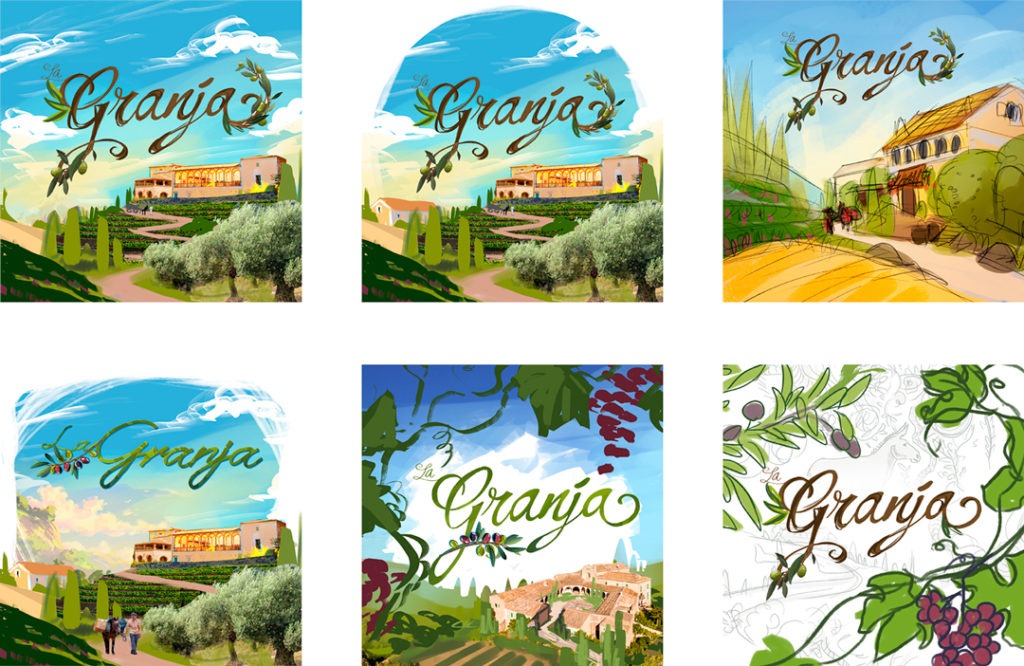
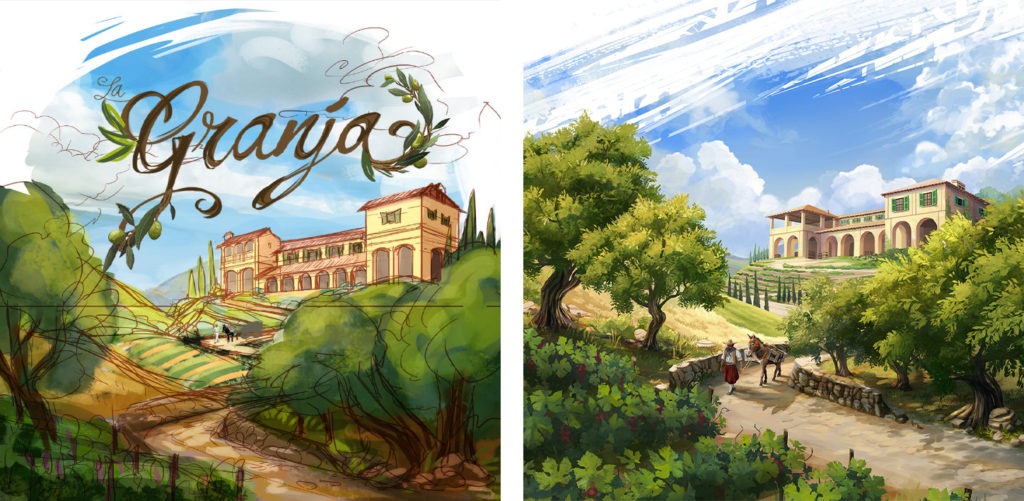

ENG | La Granja is inspired by the beautiful Spanish island of Mallorca, in a village called Esporles, which is characteristic because it preserves its original charm of stone houses and narrow streets illuminated by the Mediterranean light, how was the documentation process for its creation and how was its color palette formed?
Again references, references, and more references. I knew the basics of where and when somehow the game had its story, and I tried to find and learn as much as I could to make a believable environment and characters. From the funny facts I almost «visited» the island with Google Street View, to better catch colors, some architectural structures, and elements and characteristic plants. I hope someday to have the opportunity to visit Mallorca in person and find out how close I was to the original 🙂
ESP | La Granja está inspirada en la bella isla española de Mallorca, en un pueblo llamado Esporles, característico por conservar su encanto original de casas de piedra y calles estrechas iluminadas por la luz mediterránea, ¿cómo fue el proceso de documentación para su creación y cómo se formó su paleta de colores?
De nuevo referencias, referencias y más referencias. Sabía lo básico sobre dónde y cuándo de alguna manera el juego tenía su historia, y traté de encontrar y aprender todo lo que pude para hacer un entorno y unos personajes creíbles. De los hechos curiosos casi «visité» la isla con Google Street View, para captar mejor los colores, algunas estructuras arquitectónicas, y elementos y plantas característicos. Espero algún día tener la oportunidad de visitar Mallorca en persona y descubrir lo cerca que estuve del original 🙂

ENG | While playing La Granja we can enjoy your art in each of the elements of the game, boards, cards… what’s more, I would say that you can almost feel the smell and noise of the town market thanks to your art, how would you describe your creative process in the game?
I worked closely with the fantastic team of Board & Dice. Their Graphic designer prepared me «the base map» of every element needed for the game mechanics. My task was to make the rest «pretty».
The first idea was to make the whole main board with the top-down view – as was the original version of the game. I usually use some kind of 3D software for the architecture references. I did simple 3D models of every building needed in the game and placed them loosely on the map.
My second thought after finishing the first sketches was «hmm, maybe a different perspective will be nicer and more interesting?» I chose to show more of the front, and show some life around, add characters and animals. And that turned out to be so much more complicated but a better idea. I knew that I wanted to make it clear and as attractive as possible for the players, to give them something to contemplate between their moves. At the same time the illustrations obviously had to not interfere with the game itself.
I was lucky enough to have the full support of an amazing duet – Kuba Polkowski and Zbigniew Umgelter. Together we were moving houses, piglets, and warehouses back and forth until we found the best possible spots for them on the board.
Of course there are some easter eggs on the map. You can find there a spanish version of René Artois and a man looking like Antonio Banderas wearing an unbuttoned shirt and selling fruit on the market. The other interesting fact is that the main La Granja villa you can see on my box cover was inspired by the one from the previous cover – which, in fact, is a 1:1 interpretation of the existing building of what today is La Granja d’Esporles museum on Mallorca.
ESP | Mientras jugamos a La Granja podemos disfrutar de tu arte en cada uno de los elementos del juego, tableros, cartas… es más, diría que casi se puede sentir el olor y el ruido del mercado de la ciudad gracias a tu arte, ¿cómo describirías tu proceso creativo en el juego?
Trabajé en estrecha colaboración con el fantástico equipo de Board & Dice. Su diseñador gráfico me preparó «el mapa base» de todos los elementos necesarios para la mecánica del juego. Mi tarea consistía en hacer «bonito» el resto.
La primera idea fue hacer todo el tablero principal con la vista de arriba abajo, como era la versión original del juego. Suelo utilizar algún tipo de software 3D para las referencias arquitectónicas. Hice modelos 3D sencillos de todos los edificios necesarios en el juego y los coloqué libremente en el mapa.
Mi segundo pensamiento tras terminar los primeros bocetos fue «hmm, ¿quizá una perspectiva diferente sería más bonita e interesante?». Opté por mostrar más el frente y mostrar algo de vida alrededor, añadir personajes y animales. Y eso resultó ser mucho más complicado, pero una idea mejor. Sabía que quería hacerlo claro y lo más atractivo posible para los jugadores, darles algo que contemplar entre sus jugadas. Al mismo tiempo, obviamente, las ilustraciones no debían interferir con el juego en sí.
Tuve la suerte de contar con todo el apoyo de un dúo increíble: Kuba Polkowski y Zbigniew Umgelter. Juntos fuimos moviendo casas, cerditos y almacenes de un lado a otro hasta encontrar los mejores sitios posibles para ellos en el tablero.
Por supuesto, hay algunos easter eggs en el mapa. Puedes encontrar allí una versión española de René Artois y un hombre parecido a Antonio Banderas que lleva una camisa desabrochada y vende fruta en el mercado. El otro dato interesante es que la villa principal de La Granja que puedes ver en la portada de mi caja está inspirada en la de la portada anterior, que, de hecho, es una interpretación 1:1 del edificio existente de lo que hoy es el museo de La Granja d’Esporles en Mallorca.


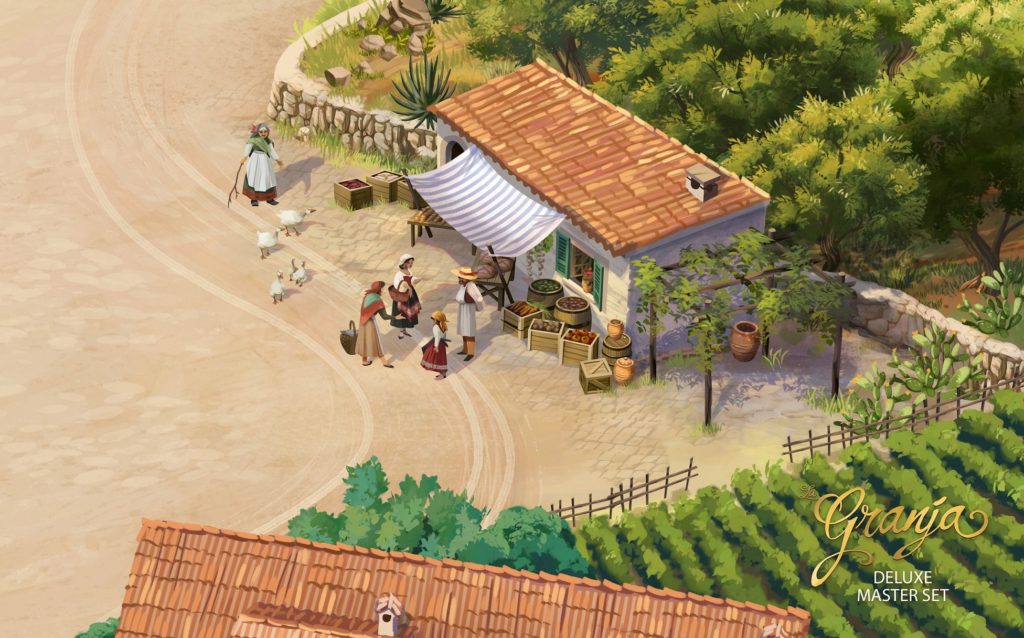
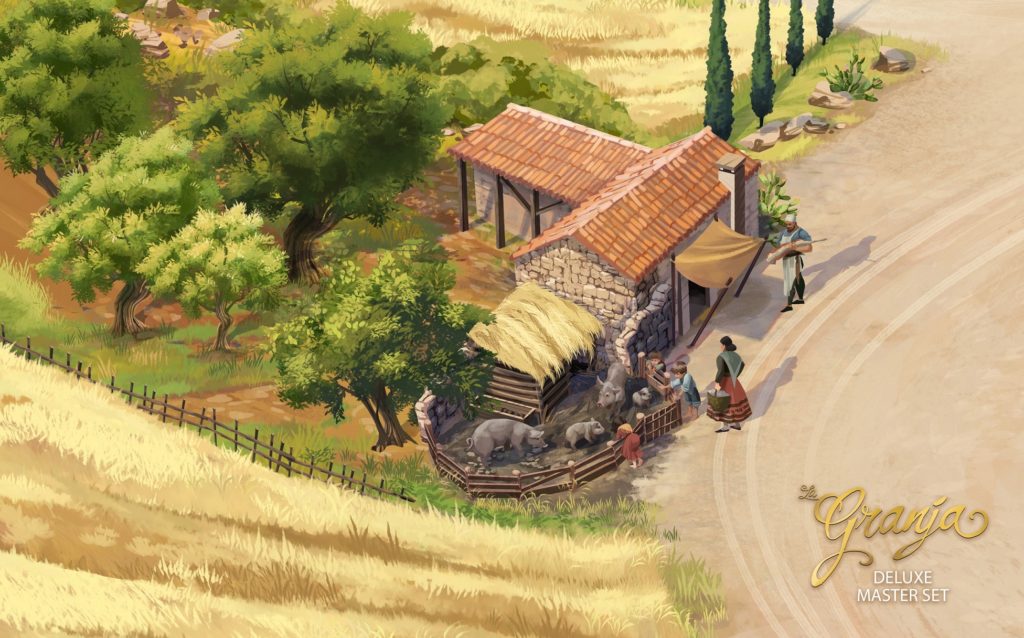
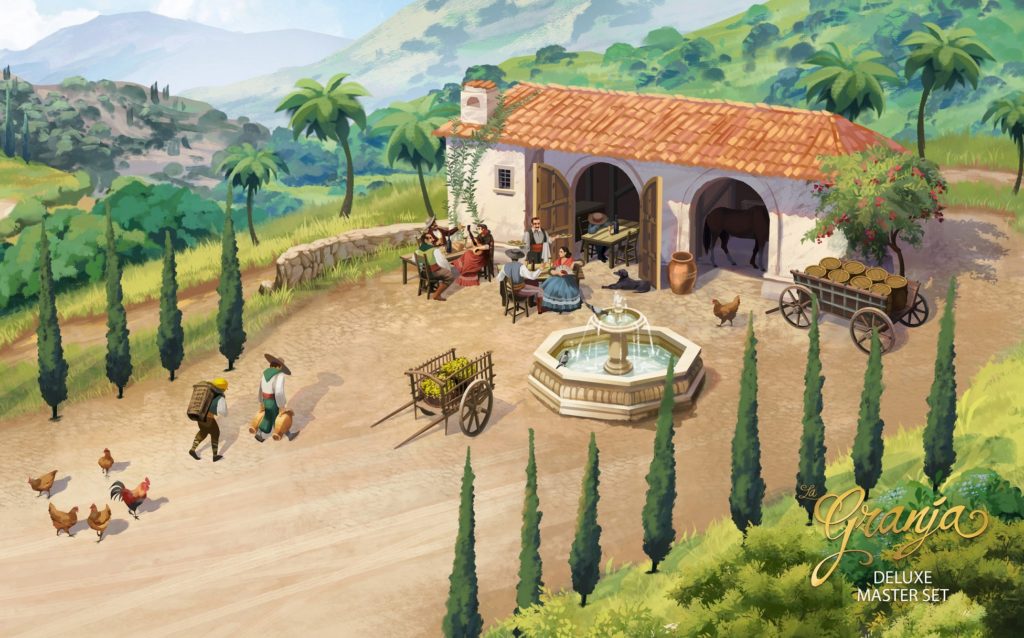
ENG | You have also illustrated the different women of the Farm with the typical costumes of the time and with poses and looks that transmit strength and confidence. Did you draw inspiration from family and friends for their creation? What was the biggest challenge, why?
This part was a little tricky. I do love drawing characters, but I was a little scared if my Ladies of La Granja would be characteristic enough for this specific region and for the players from Spain. I hadn’t had enough good refs for the clothes, so I decided to make a mix of traditional and historical costumes from different parts of this country. I gathered the elements I found the most «iconic» and beautiful and tried to put them together in the 19th century country’s life realities.
As for involving friends and family in the drawing process, I usually draw poses from the memory or, if I need something more specific, from photos of myself done in the bathroom’s mirror 😀 In this particular project there wasn’t anyone else involved, but I use my friends and husband very often in my personal projects (Huge kisses to them).
For the Ladies illustrations I got a short brief about each of them: personality, age and general body shape. The rest was my creative invention. I wanted to give the different characters, and maybe some backstories suited to their roles and occupations.
I hope I managed all of my intentions in the eyes of the players 🙂
ESP | También has ilustrado a las distintas mujeres de la Granja con los trajes típicos de la época, poses y miradas que transmiten fuerza y confianza. ¿Se inspiró en familiares y amigos para su creación? ¿Cuál fue el mayor reto, por qué?
Esta parte fue un poco complicada. Me encanta dibujar personajes, pero tenía un poco de miedo de si mis Damas de La Granja serían lo bastante características para esta región específica y para los jugadores de España. No tenía suficientes buenos referentes para la ropa, así que decidí hacer una mezcla de trajes tradicionales e históricos de diferentes partes de este país. Reuní los elementos que me parecieron más «icónicos» y bellos e intenté unirlos a las realidades vitales del país del siglo XIX.
En cuanto a involucrar a amigos y familiares en el proceso de dibujo, suelo dibujar poses de la memoria o, si necesito algo más específico, de fotos mías hechas en el espejo del baño 😀 En este proyecto en particular no hubo nadie más involucrado, pero uso a mis amigos y a mi marido muy a menudo en mis proyectos personales (Besos enormes para ellos).
Para las ilustraciones de las señoras me dieron un breve resumen sobre cada una de ellas: personalidad, edad y forma general del cuerpo. El resto fue invención mía. Quise dotar a los distintos personajes de historias de fondo adecuadas a sus funciones y ocupaciones.
Espero haber logrado todas mis intenciones a los ojos de los jugadores 🙂
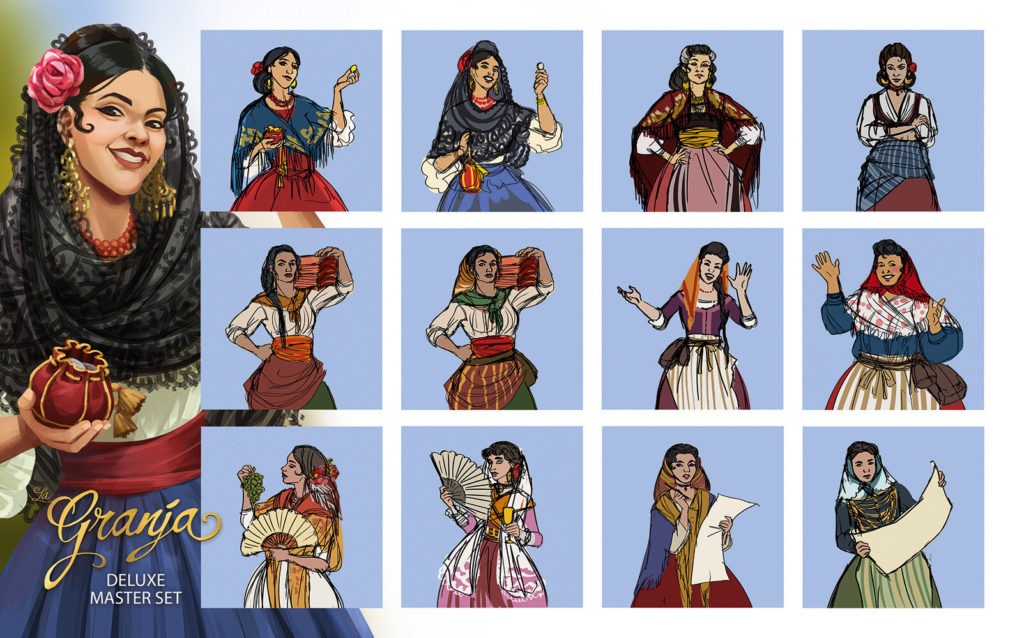

ENG | You have worked for major international board game publishers, what do you recommend to our readers to enter the international market as illustrators or designers?
Not sure about the designers but as for the illustrators I recommend having a nice portfolio, filled with pieces in the art style and category you would LOVE to draw. For example if you feel you are the best in drawing characters, but you know you would die, drawing environments – do not put them there. There is often a slim chance that enviro could be your next project and you could struggle a lot.
The other advice is do not be afraid of using references. I remember when it was seen as cheating in the digital art community. But luckily nowadays it is a normal practice. It can also save you a lot of time and make your illustrations more believable.
ESP | Has trabajado para importantes editoriales internacionales de juegos de mesa, ¿qué recomienda a nuestros lectores para entrar en el mercado internacional como ilustradores o diseñadores?
A los diseñadores no estoy seguro, pero a los ilustradores les recomiendo que tengan un buen portafolio, lleno de obras del estilo y la categoría artística que les ENCANTARÍA dibujar. Por ejemplo, si crees que eres el mejor dibujando personajes, pero sabes que te morirías dibujando entornos, no los pongas ahí. Suele haber una pequeña posibilidad de que el entorno sea tu próximo proyecto y podrías pasar muchos apuros.
El otro consejo es que no tengas miedo de utilizar referencias. Recuerdo cuando se consideraba una trampa en la comunidad del arte digital. Pero por suerte hoy en día es una práctica normal. Además, puede ahorrarte mucho tiempo y hacer que tus ilustraciones sean más creíbles.

ENG | Finally, what projects are you currently working on and where can we follow your work?
With great pleasure I can reveal that the project I’m working on currently are the illustrations for The Tormentor, from the third season of Final Girl series by Van Ryder Games. And it’s in a completely different genre than I did before. So you can be a little bit surprised seeing them 🙂
If you would like to follow my personal projects, go visit my Instagram profile @anezerynlis. For my board game illustrations please see my Artstation portfolio www.artstation.com/anez
ESP | Por último, ¿en qué proyectos está trabajando actualmente y dónde podemos seguir su trabajo?
Con gran placer puedo revelar que el proyecto en el que estoy trabajando actualmente son las ilustraciones para The Tormentor, de la tercera temporada de la serie Final Girl de Van Ryder Games. Y es de un género completamente diferente al que hacía antes. Así que puedes sorprenderte un poco viéndolas 🙂
Si quieres seguir mis proyectos personales, visita mi perfil de Instagram @anezerynlis. Para ver mis ilustraciones de juegos de mesa, visita mi portfolio de Artstation www.artstation.com/anez
Muchas gracias Anez 😉
(Todas las imágenes cedidas por Agnieszka Dabrowiecka)

